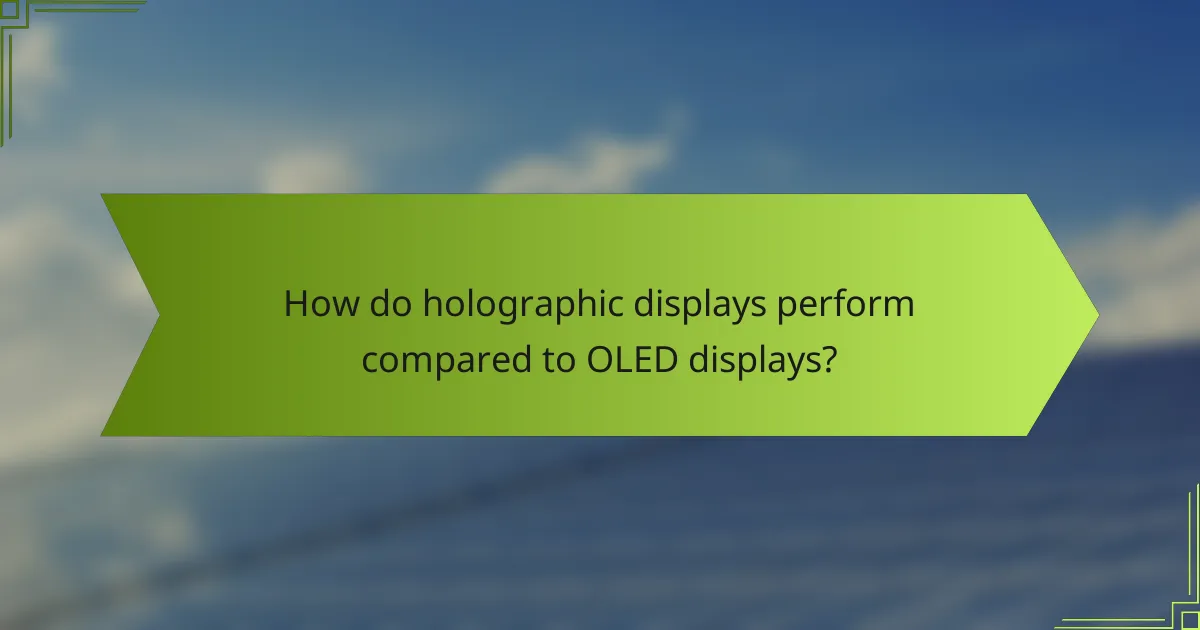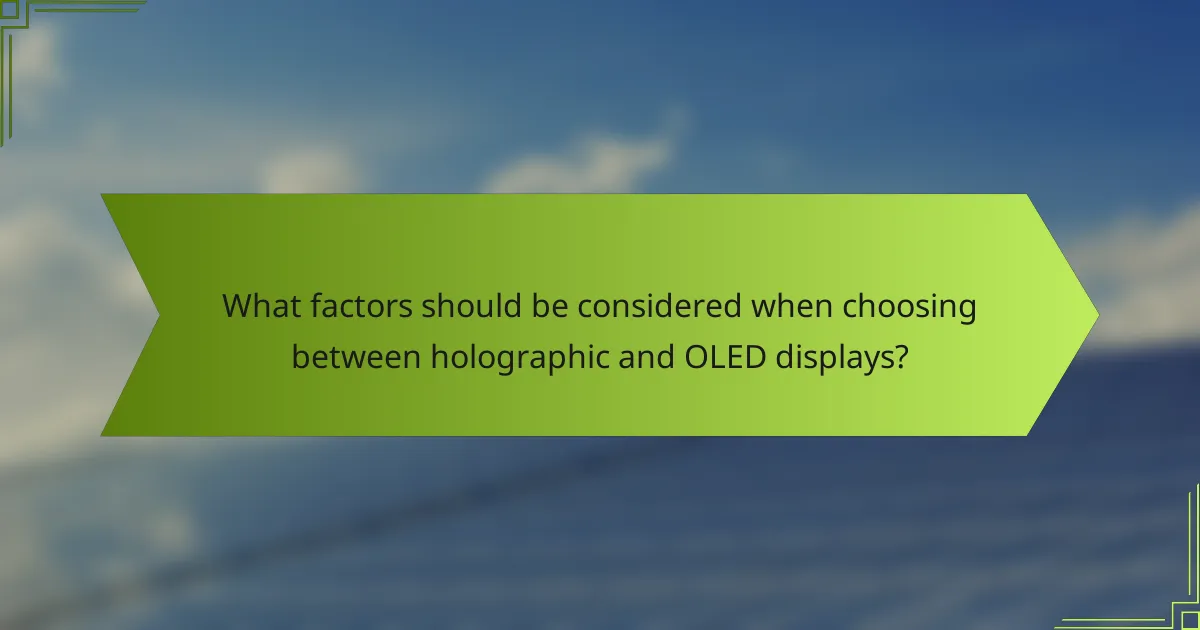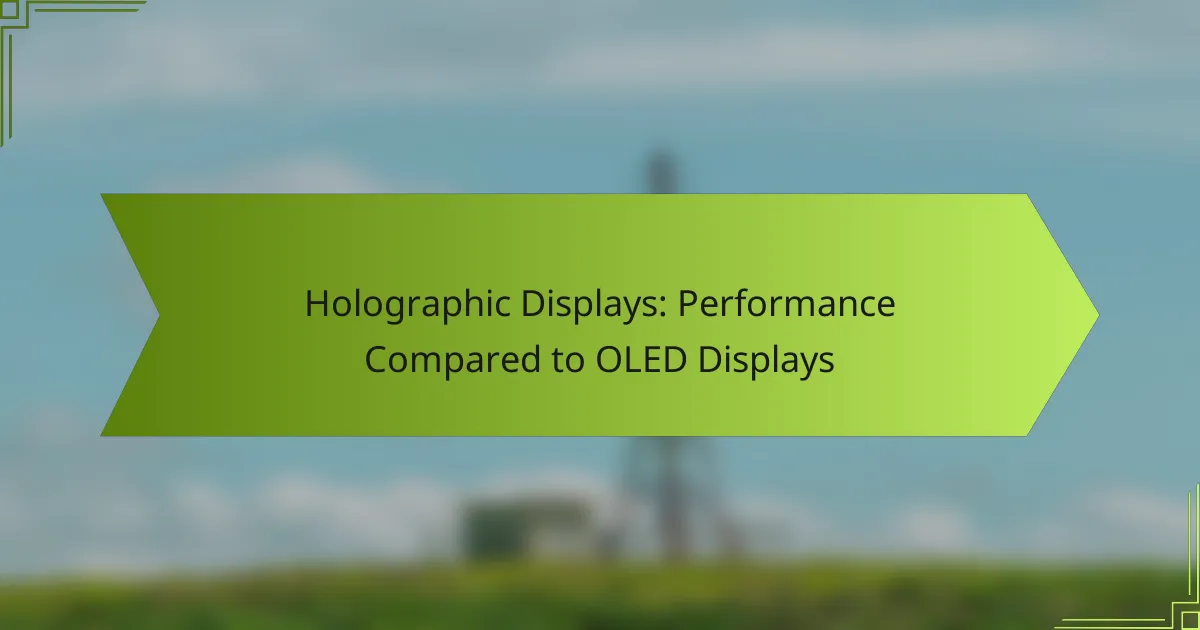Holographic displays present significant advantages over OLED displays, particularly in depth perception, viewing angles, and color accuracy, making them ideal for immersive applications. While they enhance user experience and comfort, challenges such as higher production costs and limited content availability remain. As technology evolves, the potential for holographic displays to transform fields like entertainment and education continues to grow.

How do holographic displays perform compared to OLED displays?
Holographic displays generally outperform OLED displays in several key areas, including depth perception, viewing angles, brightness, power consumption, and color accuracy. These advantages make holographic technology an appealing choice for applications requiring immersive visual experiences.
Superior depth perception
Holographic displays provide a three-dimensional viewing experience that enhances depth perception significantly compared to OLED displays. This is achieved through the projection of light fields that create the illusion of depth, allowing viewers to perceive objects at varying distances. As a result, users can interact with content in a more intuitive and realistic manner.
This depth perception is particularly beneficial in fields like medical imaging and design, where understanding spatial relationships is crucial. For example, surgeons can visualize anatomical structures more clearly, improving precision during procedures.
Wider viewing angles
Holographic displays offer wider viewing angles than OLED displays, allowing multiple viewers to see the content without color distortion or loss of image quality. This is due to the way holographic technology manipulates light, enabling a consistent visual experience from various perspectives.
In practical terms, this means that in a collaborative setting, such as a meeting or a classroom, everyone can engage with the display without needing to sit directly in front of it. This feature enhances group interactions and presentations.
Higher brightness levels
Holographic displays can achieve higher brightness levels than OLED displays, making them suitable for use in well-lit environments. This capability is essential for applications such as outdoor advertising or public displays, where visibility is critical.
Higher brightness also contributes to better contrast and clarity, allowing for more vibrant and striking visuals. Users can expect a more engaging experience, particularly in dynamic content scenarios like gaming or virtual reality.
Lower power consumption
Holographic displays typically consume less power than OLED displays, which can lead to longer operational times and reduced energy costs. This efficiency is particularly advantageous for portable devices and large installations where power supply may be a concern.
For instance, in commercial settings, lower power consumption translates to significant savings over time, making holographic technology a more sustainable choice. This aspect is increasingly important as energy efficiency becomes a priority in technology development.
Enhanced color accuracy
Holographic displays excel in color accuracy, providing a broader color gamut and more precise color reproduction compared to OLED displays. This is crucial for applications requiring true-to-life color representation, such as graphic design, photography, and video production.
With enhanced color accuracy, users can expect more vibrant and realistic images, which can improve the overall quality of visual content. This feature is particularly beneficial for professionals who rely on accurate color representation for their work.

What are the key advantages of holographic displays over OLED?
Holographic displays offer several key advantages over OLED technology, primarily in terms of user experience, visualization, and comfort. These benefits make holographic displays increasingly appealing for applications in various fields, including entertainment, education, and professional design.
Immersive user experience
Holographic displays create a more immersive user experience by allowing viewers to interact with three-dimensional images that appear to float in space. This depth perception enhances engagement, making it ideal for gaming, virtual reality, and training simulations. Users often report feeling more connected to the content, leading to a more memorable experience.
In contrast, OLED displays, while vibrant and high-quality, are limited to flat images on a screen. The lack of depth in OLED can make experiences feel less engaging, especially in applications where spatial awareness is crucial.
3D visualization capabilities
One of the standout features of holographic displays is their ability to render 3D visualizations without the need for special glasses. This capability allows for detailed representations of complex data, making it easier for professionals in fields like medicine, engineering, and architecture to analyze and present information. For example, surgeons can visualize organs in 3D during planning, improving outcomes.
OLED displays, while capable of high-resolution images, do not provide the same level of depth and interactivity. Users must rely on 2D representations, which can limit understanding and insight in certain applications.
Reduced eye strain
Holographic displays can significantly reduce eye strain compared to OLED screens. This is largely due to their ability to project images at varying depths, allowing the eyes to focus naturally without constant adjustment. Users can enjoy longer viewing times without discomfort, making holographic technology suitable for extended use in professional settings.
In contrast, OLED displays often emit blue light, which can contribute to eye fatigue and discomfort over time. Users may need to take frequent breaks when using OLED screens for prolonged periods, whereas holographic displays can offer a more comfortable viewing experience.

What are the limitations of holographic displays?
Holographic displays have several limitations that can impact their performance compared to OLED displays. Key challenges include higher production costs, limited content availability, and potential motion blur issues that can affect the viewing experience.
Higher production costs
The manufacturing process for holographic displays is generally more complex and expensive than that of OLED displays. This complexity arises from the need for advanced optics and precise alignment, which can drive up costs significantly. As a result, consumers may find holographic displays priced in the higher range, often exceeding typical OLED models.
For example, while a mid-range OLED display might cost around $500, a comparable holographic display could start at $1,000 or more, making them less accessible for average consumers.
Limited content availability
Holographic displays currently suffer from a lack of content specifically designed for their unique capabilities. Unlike OLED displays, which have a vast library of movies, games, and applications, holographic content is still in its infancy. This scarcity can limit the appeal of holographic technology for potential buyers.
As the technology matures, more content is expected to emerge, but for now, users may find themselves with fewer options, which can deter investment in holographic displays.
Potential motion blur issues
Motion blur can be a significant concern with holographic displays, particularly during fast-paced scenes. This issue arises because the technology may struggle to render moving images as clearly as OLED displays, which excel in delivering sharp visuals even during rapid motion. Users may notice a decrease in image clarity when watching action films or playing video games.
To mitigate this, manufacturers are exploring solutions such as improved refresh rates and advanced rendering techniques. However, until these improvements are widely implemented, potential buyers should consider this limitation when evaluating holographic displays.

How do OLED displays compare in performance?
OLED displays are known for their superior performance, particularly in contrast ratios and color accuracy. They utilize organic compounds that emit light when electricity is applied, allowing for deeper blacks and more vibrant colors compared to traditional LCDs.
Excellent contrast ratios
One of the standout features of OLED displays is their excellent contrast ratios, often exceeding 1,000,000:1. This is achieved because each pixel emits its own light and can be turned off completely, resulting in true blacks that enhance the overall image quality.
In practical terms, this means that scenes with both bright and dark elements can be viewed with greater clarity. For example, watching a movie with dark scenes will reveal more detail without the washed-out effect common in other display technologies.
Vibrant color reproduction
OLED displays excel in vibrant color reproduction, often covering a wide color gamut that can exceed 100% of the sRGB spectrum. This capability allows for more lifelike images, making them ideal for applications in photography, gaming, and graphic design.
Users can expect rich, saturated colors that pop off the screen, enhancing the viewing experience. This is particularly beneficial in environments where color accuracy is crucial, such as digital art studios or film production.
Established market presence
OLED technology has a well-established market presence, with numerous manufacturers producing a variety of devices, from smartphones to large-screen TVs. This widespread adoption has led to competitive pricing and a range of options for consumers.
As a result, buyers can find OLED displays at various price points, making them accessible for both high-end and budget-conscious consumers. Additionally, the growing popularity of OLED has spurred ongoing advancements in the technology, ensuring that performance continues to improve over time.

What factors should be considered when choosing between holographic and OLED displays?
When choosing between holographic and OLED displays, consider factors such as image quality, viewing angles, cost, and application suitability. Each technology has unique strengths and weaknesses that can significantly impact user experience and performance.
Image Quality
Image quality is a critical factor when comparing holographic and OLED displays. OLED displays are known for their vibrant colors and high contrast ratios, making them ideal for media consumption. Holographic displays, while still developing, offer depth perception and a three-dimensional viewing experience that can enhance certain applications, such as simulations and design visualization.
Viewing Angles
Viewing angles can greatly affect how content is perceived on both display types. OLED displays typically provide wide viewing angles with consistent color and brightness, which is beneficial for group viewing. Holographic displays may have more limited optimal viewing angles, which can restrict the number of viewers who can experience the full effect simultaneously.
Cost
Cost is a significant consideration when selecting between holographic and OLED displays. OLED technology has become more affordable due to widespread adoption, with prices ranging from hundreds to thousands of USD depending on size and features. Holographic displays, being relatively new and less common, tend to be more expensive, often costing several thousand USD, which may limit their accessibility for everyday consumers.
Application Suitability
Application suitability is essential when deciding on a display type. OLED displays excel in traditional media applications, such as televisions and smartphones, where color accuracy and contrast are paramount. Holographic displays are more suited for specialized fields like medical imaging, architectural visualization, and training simulations, where the ability to view 3D models can provide significant advantages.
